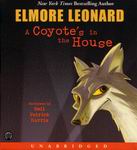
 A Coyote In The House
A Coyote In The House
By Elmore Leonard; Read by Neil Patrick Harris
3 CDs – 3 Hours [UNABRIDGED]
Publisher: Harper Children’s Audio
Published: 2004
ISBN: 0060728825
Themes: / Fantasy / Anthropomorphic Fiction / Movies / Crime /
This dog was cool for a homeboy, an older male who had peed all over this big yard, marking it to let everybody know this was his turf and nobody else’s. Keep it, homes. Live here and get food handed to you. Believe you’re somebody in your pitiful kept world, no better than a slave.”
Buddy’s the aging movie star, Antwan’s the streetwise hipster and Miss Betty is the showgirl. Buddy also happens to be a German Shepherd, Antwan is a wild and wily Coyote and Miss Betty is a bouffant Poodle. A Coyote In The House is a kid’s book in the tradition of Jack London’s The Call of The Wild. In essence this it is the same story, simply with a sub-urban as opposed to an arctic setting – that and Elmore Leonard’s patented prose. It’s not just Leonard’s dialogue that’s distinctive; it’s his story structure, characters, and cadence that all scream Elmore Leonard. And that’s very disconcerting. Leonard hasn’t written anything but adult crime novels and westerns so to hear this audiobook was truly odd. I think kids and adults who listen with together will both be pleased. It’s a fun story but it’s a strange experience for fans of Elmore Leonard’s other novels.
I couldn’t get over how Leonard completely ignores the impossibility of the situation he’s created. I know it’s a kid’s story, and kids won’t likely see it the way I do, but this story is utterly impossible. It basically ignores everything we do know about animal intelligence and replaces it with hipster lingo and human motivations and then marches on, oblivious to all the impossibilities those things entail. As an example, Buddy, the aging German Shepherd movie star, watches his old movies all day long – every animal in A Coyote In The House is intimately familiar with movies and movie stars – this despite the story logic that these canines, felines and avians can’t understand most of what humans say (and vice versa). Further, the animals can’t manipulate objects with their paws like in a Disney movie say, and yet somehow Buddy is able to – off screen – grab a VHS tape of one of his movies put it in the VCR and watch it, rewind it and put it back before his owners get home and see him. “Oh come on,” you say. “It’s a kids story, it doesn’t have to make sense.” Maybe. It didn’t ruin the experience for me but it didn’t let me fully enjoy it either. I just think that it’d have been a far better story to tackle, realistically, the animal’s perspective head on.
One other curious thing of note. The use of the word “bitch.” In any other Leonard novel it wouldn’t be a novelty – here it refers doubly as a slang term (for adult listeners) and as a female canine for children. Some adults may have a problem letting their kids hear such words, when the usage is not clear cut but I think that’d be the wrong attitude to take – the word is legitimately used here and I’d be far more concerned about kids thinking that animals are just like people – when they aren’t – than learning a “bad” word. Performed by Neil Patrick Harris, A Coyote In The House has a goodly number characters with distinctive voices. Harris is quite impressive as a reader! His audiography seems to consist mostly of children’s novels, perhaps a legacy from his child stardom. In any case he’d be a good reader of adult novels too.
Posted by Jesse Willis
 Ender’s Game
Ender’s Game The Giver
The Giver Time Bride
Time Bride